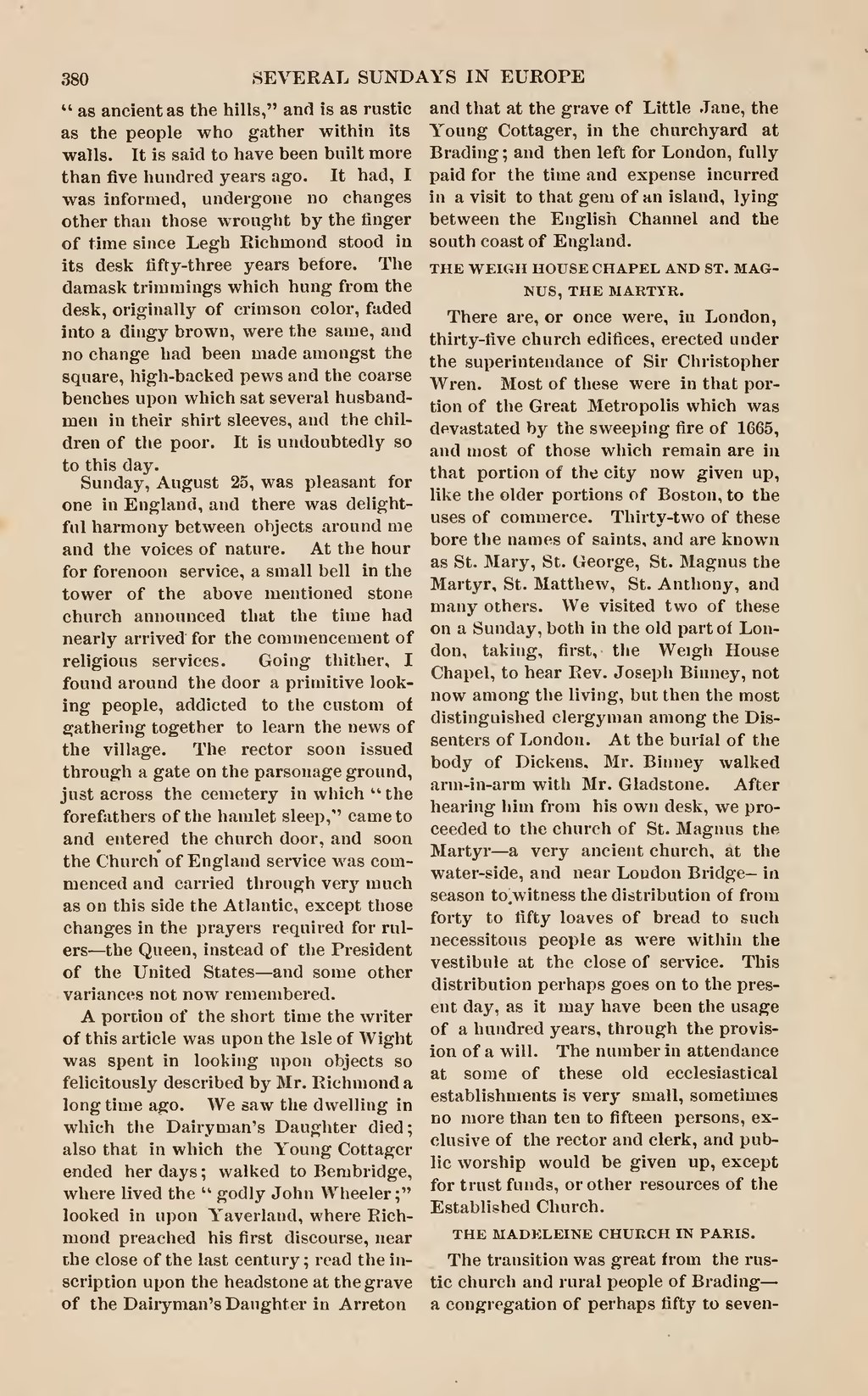380
��SEVERAL SUNDAYS IN EUROPE
��" as ancient as the hills," and is as rustic as the people who gather within its walls. It is said to have been built more than five hundred years ago. It had, I was informed, undergone no changes other than those wrought by the finger of time since Legh Richmond stood in its desk fifty-three years before. The damask trimmings which hung from the desk, originally of crimson color, faded into a dingy brown, were the same, and no change had been made amongst the square, high-backed pews and the coarse benches upon which sat several husband- men in their shirt sleeves, and the chil- dren of the poor. It is undoubtedly so
to this day. Sunday, August 25, was pleasant for
one in England, and there was delight- ful harmony between objects around me and the voices of nature. At the hour for forenoon service, a small bell in the tower of the above mentioned stone church announced that the time had nearly arrived' for the commencement of religious services. Going thither, I found around the door a primitive look- ing people, addicted to the custom of gathering together to learn the news of the village. The rector soon issued through a gate on the parsonage ground, just across the cemetery in which "the forefathers of the hamlet sleep,"' came to and entered the church door, and soon the Church of England service was com- menced and carried through very much as on this side the Atlantic, except those changes in the prayers required for rul- ers — the Queen, instead of the President of the United States — and some other variances not now remembered.
A portion of the short time the writer of this article was upon the Isle of Wight was spent in looking upon objects so felicitously described by Mr. Richmond a longtime ago. We saw the dwelling in which the Dairyman's Daughter died; also that in which the Young Cottager ended her days ; walked to Bembridge, where lived the " godly John Wheeler;" looked in upon Yaverland, where Rich- mond preached his first discourse, near the close of the last century; read the in- scription upon the headstone at the grave of the Dairyman's Daughter in Arreton
��and that at the grave of Little Jane, the Young Cottager, in the churchyard at Brading; and then left for London, fully paid for the time and expense incurred in a visit to that gem of an island, lying between the English Channel and the south coast of England.
THE WEIGH HOUSE CHAPEL AND ST. MAG- NUS, THE MARTYR.
There are, or once were, in London, thirty-five church edifices, erected under the superintendance of Sir Christopher Wren. Most of these were in that por- tion of the Great Metropolis which was devastated by the sweeping fire of 1665, and most of those which remain are in that portion of the city now given up, like the older portions of Boston, to the uses of commerce. Thirty-two of these bore the names of saints, and are known as St. Mary, St. George, St. Magnus the Martyr, St. Matthew, St. Anthony, and many others. We visited two of these on a Sunday, both in the old part of Lon- don, taking, first, the Weigh House Chapel, to hear Rev. Joseph Binney, not now among the living, but then the most distinguished clergyman among the Dis- senters of London. At the burial of the body of Dickens. Mr. Binney walked arm-in-arm with Mr. Gladstone. After hearing him from his own desk, we pro- ceeded to the church of St. Magnus the Martyr — a very ancient church, at the water-side, and near Loudon Bridge— in season to/witness the distribution of from forty to fifty loaves of bread to such necessitous people as were within the vestibule at the close of service. This distribution perhaps goes on to the pres- ent day, as it may have been the usage of a hundred years, through the provis- ion of a will. The number in attendance at some of these old ecclesiastical establishments is very small, sometimes no more than ten to fifteen persons, ex- clusive of the rector and clerk, and pub- lic worship would be given up, except for trust funds, or other resources of the Established Church.
THE MADELEINE CHURCH IN PARIS.
The transition was great from the rus- tic church and rural people of Brading — a congregation of perhaps fifty to seven-
�� �
